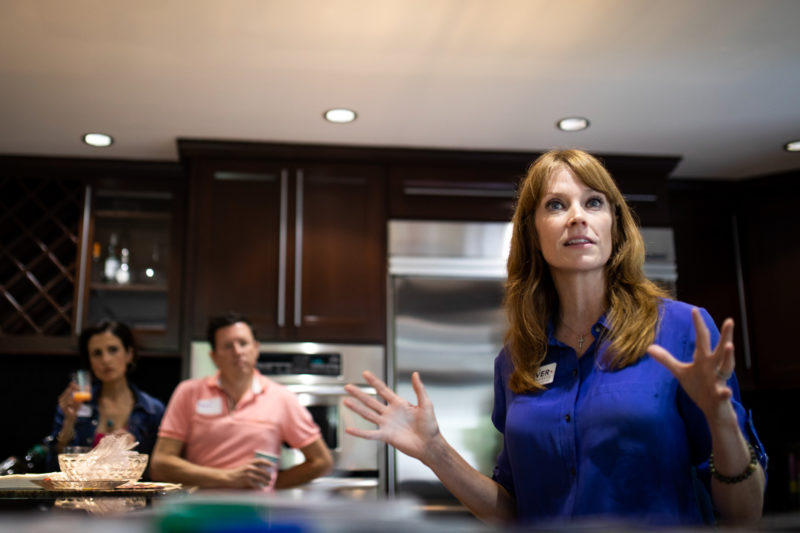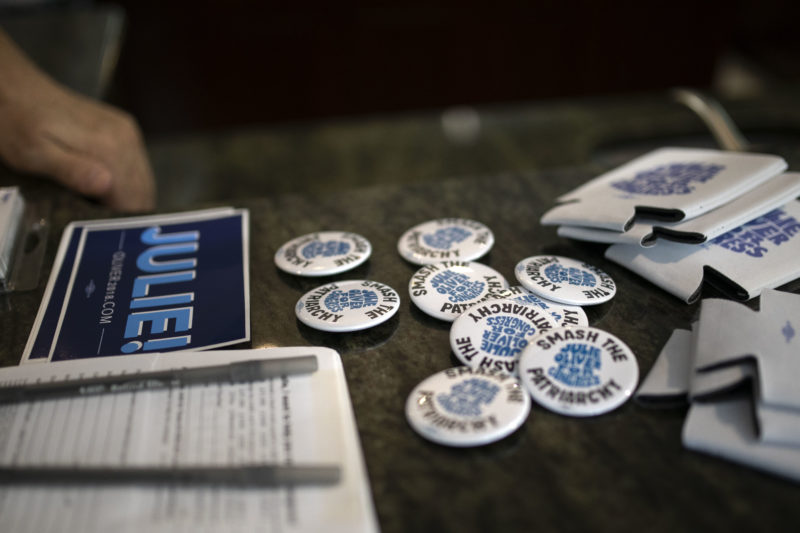Despite Dynamic Campaign, Julie Oliver Faces Uphill Battle for Congress
By KATE GROETZINGER
Reporting Texas

Julie Oliver speaks to supporters at a fundraiser on Sept. 22, 2018. Salvador Castro/Reporting Texas.
Julie Oliver has put more than 42,000 miles on her white hatchback BMW driving up and down I-35 this year. She also lost 15 pounds and gained a grey streak in her strawberry blond hair. That’s what it takes, apparently, for a Democrat to run for Congress in Texas’s 25th District, which stretches over 200 miles through 13 counties from Austin to Fort Worth.
Oliver is taking on U.S. Rep. Roger Williams, a Republican businessman who was elected in 2012, after the district was redrawn by Republicans in 2011. While the odds are stacked against Oliver — the gerrymandered district went for President Trump by almost 15 points in 2016 — Oliver has some advantages over other Democrats who have run in the district.
Popular El Paso congressman Beto O’Rourke is running for a U.S. Senate seat, which is expected to drive voter turnout among Democrats, and the rising cost of living in Fort Worth and Austin has pushed some people out of those cities, making the rural parts of the district less reliably red. Those factors, combined with increased enthusiasm among Democrats in the age of President Donald Trump, have fueled excitement for Oliver’s campaign.
The 46-year-old Oliver, a former teenage mother who put herself through law school, has an adult son with a heart condition and an immune deficiency disorder. Without the Affordable Care Act, commonly called Obamacare, he wouldn’t be able to afford health insurance, she said. After repeated attempts by Republicans to repeal the ACA in 2017, Oliver decided she had to do something.
“I went to my husband, Matt, at first, and I asked him if he would run for Congress. And when he said no, I knew I had to. Mama Bear came out,” she said. Oliver and her husband, who is her campaign manager, both put their careers on hold and dipped into their retirement funds to campaign in this election.
Oliver has promised to fight to expand the ACA if elected, and her focus on healthcare resonates well with moderate voters in the rural parts of her district, she said. In Stephenville in September, Oliver appeared on a panel of Democrats running for office in the district. The candidates talked about protecting Social Security and Medicare, expanding job opportunities and bringing high-speed internet to the area.
In the urban parts of the district, Oliver’s progressive side comes out. She opened for O’Rourke at a recent rally at the University of Texas at Austin, where she attended law school. It was the fourth time she has appeared with O’Rourke. In a five-minute speech, Oliver touched on student debt, sexual assault, prison reform and immigration reform.
“Do we want to be a country known for separating parents and children at our borders? Can I get a ‘Hell, no!” Oliver said.
The biggest challenge for most politicians running against a popular incumbent is achieving widespread name recognition. Appearing with O’Rourke has helped Oliver. She opened for him at a rally in Hamilton County in August that drew 300 people, about 5 percent of registered voters in the county. Oliver has also copied O’Rourke’s aggressive grassroots approach to campaigning. She’s made showing up to events in person a priority and has visited all 13 counties in her district at least twice. She has six people working full-time on her campaign and, like O’Rourke, has sworn off money from political action committees.

Julie Oliver campaign paraphernalia at a fundraiser on Sept. 22, 2018. Salvador Castro/Reporting Texas.
Meanwhile, Williams has been all but invisible. He has only held private fundraising events for donors, according to his campaign office. The fundraisers seem to have paid off. Williams pulled in almost $1.5 million this election cycle, a third of which came from PACs.
Cathy Moss is part of a small contingent of Democrats in Somervell County, in the northern part of the 25th district. Moss said she’s been tracking Williams’ campaign actions. “The only thing we’ve heard from him is he showed up, unannounced, at a senior citizen home and just walked around,” she said.
Despite the lack of Democratic success in past elections, Oliver said she can win in District 25. She cited an increase in Democratic primary voters during the past four years. The number of Democratic primary voters in the district increased from about 15,500 in the 2014 midterm election to more than 27,000 this year.
Demographic changes likely explain some of the increased Democratic voter turnout in the district. “We are at the end of the redistricting cycle,” said Jim Henson, a political scientist at UT Austin. “These districts are not the same as when Republicans drew them the first time.” Hays County, which is in District 25, was the fastest growing county in the state last year, and Tarrant County, also in District 25, was the fifth fastest growing county in the nation. The majority of this growth is due to migration, not births, according to U.S.census data.

Julie Oliver speaks with Lucy Clark, a young supporter of Oliver’s campaign at the Family Block Party with Julie Oliver on Oct. 14, 2018. Salvador Castro/Reporting Texas.
Still, Oliver’s odds are long, Henson said. “I don’t look at this and see an obvious path to victory, other than a dramatic increase in Travis County turnout. But given what we’re seeing in this cycle, that’s not out of the question,” he said.
While no polling has been done on the race, political forecasters are using other factors to estimate the outcome. FiveThirtyEight, a website known for predicting elections, used polling of similar districts and factors such as fundraising to estimate Oliver’s chance of winning. At the beginning of October, FiveThirtyEight estimated her chances of winning at 6 percent. That number jumped to 13 percent on October 15, due to FEC filings showing that Oliver out-raised Williams by $280,000 in the last fundraising cycle.
“Obviously out-raising an incumbent is impressive, but cash-on-hand is more important,” said Matt Mackowiak, chairman of the Travis County Republican Party. “Roger Williams will win this election. I’m very certain of that.”
Whether Oliver wins or loses, the strength of her campaign is a departure from the norm for Democrats running in most of Texas. Kathi Thomas, the District 25 Democratic challenger to Williams in 2016 only raised $50,000 during that campaign. Oliver has raised $530,000.
“This is a big step, but you also need follow through,” Henson said. “That’s how we’ll really be able to tell whether what we’re seeing now is a blip that is a function of an alignment of factors in the state and national environment. When they recede, which they will, can Democrats carry this on?”